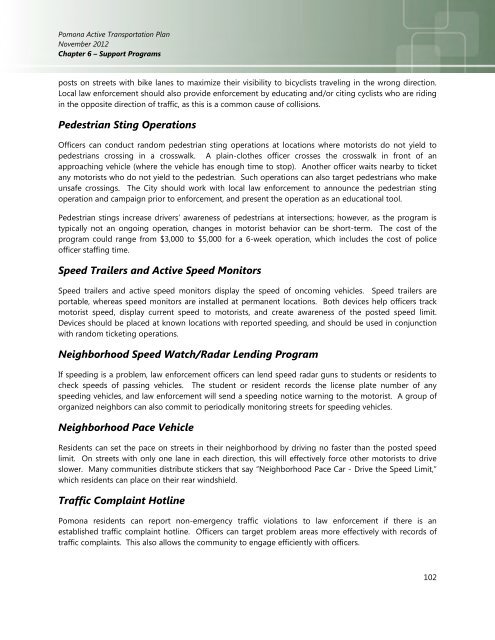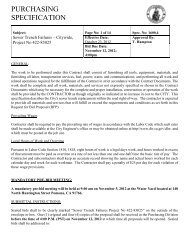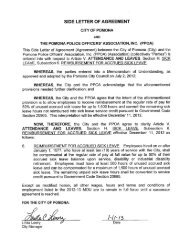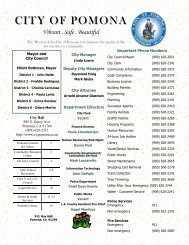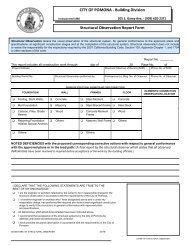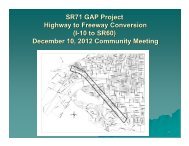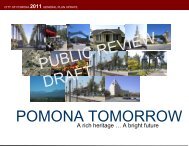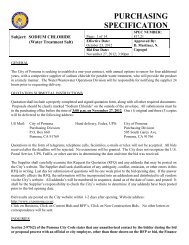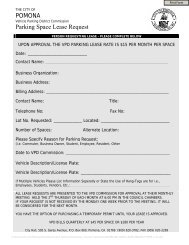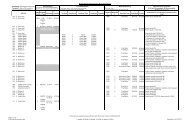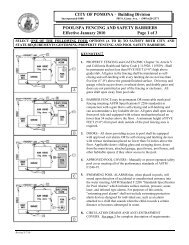Active Transportation Plan - City of Pomona
Active Transportation Plan - City of Pomona
Active Transportation Plan - City of Pomona
Create successful ePaper yourself
Turn your PDF publications into a flip-book with our unique Google optimized e-Paper software.
<strong>Pomona</strong> <strong>Active</strong> <strong>Transportation</strong> <strong>Plan</strong><br />
November 2012<br />
Chapter 6 – Support Programs<br />
posts on streets with bike lanes to maximize their visibility to bicyclists traveling in the wrong direction.<br />
Local law enforcement should also provide enforcement by educating and/or citing cyclists who are riding<br />
in the opposite direction <strong>of</strong> traffic, as this is a common cause <strong>of</strong> collisions.<br />
Pedestrian Sting Operations<br />
Officers can conduct random pedestrian sting operations at locations where motorists do not yield to<br />
pedestrians crossing in a crosswalk. A plain-clothes <strong>of</strong>ficer crosses the crosswalk in front <strong>of</strong> an<br />
approaching vehicle (where the vehicle has enough time to stop). Another <strong>of</strong>ficer waits nearby to ticket<br />
any motorists who do not yield to the pedestrian. Such operations can also target pedestrians who make<br />
unsafe crossings. The <strong>City</strong> should work with local law enforcement to announce the pedestrian sting<br />
operation and campaign prior to enforcement, and present the operation as an educational tool.<br />
Pedestrian stings increase drivers’ awareness <strong>of</strong> pedestrians at intersections; however, as the program is<br />
typically not an ongoing operation, changes in motorist behavior can be short-term. The cost <strong>of</strong> the<br />
program could range from $3,000 to $5,000 for a 6-week operation, which includes the cost <strong>of</strong> police<br />
<strong>of</strong>ficer staffing time.<br />
Speed Trailers and <strong>Active</strong> Speed Monitors<br />
Speed trailers and active speed monitors display the speed <strong>of</strong> oncoming vehicles. Speed trailers are<br />
portable, whereas speed monitors are installed at permanent locations. Both devices help <strong>of</strong>ficers track<br />
motorist speed, display current speed to motorists, and create awareness <strong>of</strong> the posted speed limit.<br />
Devices should be placed at known locations with reported speeding, and should be used in conjunction<br />
with random ticketing operations.<br />
Neighborhood Speed Watch/Radar Lending Program<br />
If speeding is a problem, law enforcement <strong>of</strong>ficers can lend speed radar guns to students or residents to<br />
check speeds <strong>of</strong> passing vehicles. The student or resident records the license plate number <strong>of</strong> any<br />
speeding vehicles, and law enforcement will send a speeding notice warning to the motorist. A group <strong>of</strong><br />
organized neighbors can also commit to periodically monitoring streets for speeding vehicles.<br />
Neighborhood Pace Vehicle<br />
Residents can set the pace on streets in their neighborhood by driving no faster than the posted speed<br />
limit. On streets with only one lane in each direction, this will effectively force other motorists to drive<br />
slower. Many communities distribute stickers that say “Neighborhood Pace Car - Drive the Speed Limit,”<br />
which residents can place on their rear windshield.<br />
Traffic Complaint Hotline<br />
<strong>Pomona</strong> residents can report non-emergency traffic violations to law enforcement if there is an<br />
established traffic complaint hotline. Officers can target problem areas more effectively with records <strong>of</strong><br />
traffic complaints. This also allows the community to engage efficiently with <strong>of</strong>ficers.<br />
102


